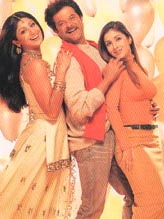The
greater the hype of a film, the deeper
its fall. Badhaai Ho Badhaai director
Satish Kaushik must be given 'badhaai'
(congrats) for putting across a message
of communal harmony (strangely, Hindu
vs Christian) in a loosely held package
of his own visual flashes of wild
fantasies.
It looks as if he wanted some outlet
to create certain sequences, hallucinations
so to say, of spectacle and grandeur,
whenever he got a chance to push them
into one of his films, whether they
fit into the screenplay or not. Watch
Shilpa Shetty suddenly lapsing into
a dream which takes her back thousands
of years back into ancient India.
There she is decked presumably in
an Amrapali outfit dancing with Anil
Kapoor dressed up in matching clothes
along with dozens of girls in the
backdrop of ancient ruins of a temple
complex.
Does that Punjabi Christian female
character have any iidea of those
times and people, their costumes etc.
An individual cannot harbour something
in his or her subconscious which has
not been experienced, felt or seen.
At least one should have read about
it. But there is no such indication
in the portrayal of this character
of Banto.
There
are other similar sequences in which
Kaushik has taken the producer as
well as the audience for a ride. All
in the name of entertainment.
The
kind of hatred displayed between two
families, one Christian and the other
Hindu, which is the cause of all trouble
for the lovers, is absolutely unconvincing.
Even if the film is meant to be a
light-hearted comedy, there should
be some semblance of realism in the
story, otherwise, it fails totally
in its inherent purpose of conveying
a message to society.
This is exactly what Kaushik attempts
to do in a rather oddly overt manner.
Since both are upper class modern,
westernised families, the whole thing
looks far more phoney. Normally, it's
the women in the family who are supposed
to be more orthodox. But in this film
it is the male's religious ego that
plays havoc with the lives of two
generations of their families.
Anil
Kapoor's role is a bundle of fun and
silent sacrifice. But the character
has a strong resemblance with the
protagonist in Vijay Tendulkar's play
Ashi Pankhree Yete (Thus comes flying
the bird). He volunteers to help Florence
(Kirti Reddy) in finding her love,
though he himself loved her madly,
and after achieving what he wanted
to do, he departs. That's also broadly
the theme of the play.
The
worst part is open projection of a
few commercial firms in the various
scenes of the film. An obese Anil
Kapoor takes a slimming course at
a clinic run in Delhi by Vandana Luthra.
Two others are well-known  showrooms
o Karol Bagh, one a jewellers for
whom Shilpa Shetty has been dancing
on TV screens and the other a men's
wear shop. Women from the two families
(Rohini Hattangady and Farida Jalal)
are shown in the vicinity.
showrooms
o Karol Bagh, one a jewellers for
whom Shilpa Shetty has been dancing
on TV screens and the other a men's
wear shop. Women from the two families
(Rohini Hattangady and Farida Jalal)
are shown in the vicinity.
This
kind of open advertisement of commercial
places is not allowed in Hollywood
or European films. In most cases names
are changed. It is not a healthy practice.
The censor board should look into
this matter , because such a display
is to be prejudicial to rival firms
in the same line of business. -by
Our Film Critic June 15, 2002
-by
Our Film Critic
June 15, 2002